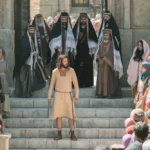Is The Lord of the Rings Based on a True Story? – The eagerly anticipated prequel to Peter Jackson’s Tolkien film adaptations is finally available. It is exactly what you’d expect: beautifully staged and entirely accurate to the pace and tone of the films. The first episode of the eight-part series shows a Middle-earth that is mainly calm, with Galadriel (Morfydd Clark) being the only elf who can see the terrible future ahead. The orc danger is no longer of concern to the Elvish, but Galadriel embarks on a solo mission to track down Sauron’s goons because she is haunted by what happened to her brother, particularly by the mark that was left on his hand.
A vast fantasy fall will start on Prime Video on Friday, September 2. The Patrick McKay and John D. Payne-created television series is set in a setting that is distinct from that of the films and books but is yet connected to them. Given how vital Tolkien’s universe has been, you might be curious about its origins. For what reason did he choose to compose “The Lord of the Rings”? Are the incidents therein actual? Let’s find out if “The Lord of the Rings” is based on a true story or not.
Must Read: Is Amazon’s ‘The Rings Of Power’ Based On A Book?
Is The Lord of the Rings a True Story?
NO, “The Lord of the Rings” is not a story that really happened. His tales are not based on actual historical events, so they are not true. J. R. R. Tolkien’s book The Lord of the Rings and its appendices inspired The Lord of the Rings: The Rings of Power. The series, produced by J. D. Payne and Patrick McKay for the streaming service Prime Video, takes place in the Second Age of Middle-earth, thousands of years before Tolkien’s The Hobbit and The Lord of the Rings. But to create a world as expansive as Tolkien’s, a storyteller must have ideas. He was grading papers when he received the idea for “The Hobbit.” He wrote the first phrase of a fantasy masterwork on a piece of blank paper. He completed the story after two years, and it was a commercial and critical success.
Most of the magical creatures from “The Hobbit” and “The Lord of the Rings” were accessible to the author. He was a gifted linguist who was influenced by the mythologies and languages of the Greek, Germanic, Celtic, Finnish, and Slavic peoples. His fiction reflected both his Christian beliefs and his appreciation of fantasy and adventure books as a child. He drew on Greek, Celtic, Germanic, Slavic, and Norse mythology.
Thanks to his linguistic expertise, he created distinct voices for each species in his Christian and Jewish-inspired fables. Tolkien’s knowledge of Jewish history may have influenced the characteristics and history of the dwarves in “The Hobbit.”
JRR Tolkien’s Middle Earth has captivated fans for decades, yet few are aware of its source. Since its release in 1954, The Lord of the Rings has sold over 150 million copies. The Peter Jackson trilogy of movies is regarded as among the best and most influential ever made. Since the 1937 publication of The Hobbit, readers have been enthralled by Middle Earth, but it’s easy to forget the tale’s humble beginnings. Because elves, dwarves, wizards, and other magical creatures call the fantasy world home.
Watch the Official Trailer for #TheRingsOfPower now. Join us in Middle-earth on September 2.pic.twitter.com/TEXeaa1gVP
— The Lord of the Rings on Prime (@LOTRonPrime) August 23, 2022
Additionally, Tolkien used personal tales. It is well acknowledged that the sites that mostly inspired Tolkien’s realm were in and around Birmingham. The author’s parents were both born in the West Midlands before moving to South Africa in the early 20th century. However, Tolkien’s extended family persisted, and when he was a young child, he visited his grandparents with his mother and brother in England’s second city.
The three of them decided to settle in the neighboring hamlet of Sarehole when Tolkien learned of his father’s passing on one of these visits. During Tolkien’s extensive area travels with his brother, Sarehole is said to have been the source of inspiration for The Shire.
The Old Mill in Hobbiton was explicitly based on Sarehole Mill. After his mother left, Tolkien moved in with his aunt in the Edgbaston neighborhood of Birmingham. The tower at Egbaston Waterworks and Perrott’s Folly, two famous structures in Edgaston, inspired Minas Morgul and Minas Tirith in The Two Towers. Tolkien loved Sarehole’s picturesque surroundings despite feeling romantic and alienated by the West Midlands’ transformation as industrialization grew.
In his writings, rural surroundings are usually romanticized, and it is clear that he despises industry. It is said that Tolkien was motivated by the difference between urban Birmingham and rural areas like Sarehole when he decided to depict the former as Mordor and the latter as The Shire.
The events in The Lord of the Rings: The Rings of Power Series are set thousands of years before those in The Hobbit and The Lord of the Rings and are based on J. R. R. Tolkien’s history of Middle-earth. The construction of the Rings of Power, Sauron the Dark’s ascension to power, the obliteration of the island realm of Nmenor, and the ultimate union of Elves and Men are all major Second Age events in Middle-earth that are covered in the book, which begins at a time of mainly peace. These events take place over a long period in Tolkien’s original stories, but the series has compressed them.
Considering everything, we can conclude that while “The Lord of the Rings” and its world are not based on actual events, a lot of work and research have gone into making it seem as authentic and grounded as possible, something that people can relate to and love even though it is set in a fantasy world.















